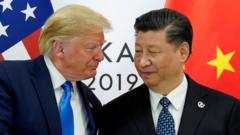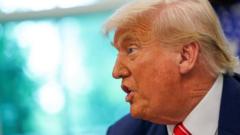The article highlights an upbeat response from stock markets following President Trump's recent decision to pause tariffs affecting numerous countries while maintaining high tariffs on China, raising concerns over potential inflation and economic growth impacts.
### Market Optimism Amidst Tariff Uncertainty

### Market Optimism Amidst Tariff Uncertainty
As President Trump places a temporary hold on several tariffs, global markets respond positively while concerns linger regarding the ongoing trade tensions.
In Asia and Europe, stocks posted significant gains after Trump's pause on tariffs but analysts suggest uncertainty remains, particularly regarding the impending effects of U.S.-China trade tensions which include steep tariffs reaching 125% on Chinese imports. Investors are also awaiting an economic report on the Consumer Price Index to understand inflation trends.
Despite the relief rally sparked by the pause, with the S&P 500 seeing its most significant rise since 2008, concerns remain about the overall economic outlook, including the effects of still-in-place tariffs and the uncertainty they bring to business operations.
####
Global financial markets enjoyed a surge early Thursday following President Trump’s announcement of a 90-day pause on tariffs on many nations while substantive tariffs on Chinese imports remained intact. Following a turbulent week punctuated by volatility, markets reacted positively, with notable gains across Asia and Europe.
This decision followed escalating tensions between the U.S. and China, where tariffs on Chinese goods soared to an unprecedented 125%. The president appears to be using this respite to leverage negotiations, suggesting that he is open to discussions with China to reach a more amicable trade agreement.
However, while investor sentiment improved with newfound optimism in stock indexes — notably with Taiwan and Japan hitting over 9% increases — economists warn that the full ramifications of the ongoing trade war are still pending and will take time to manifest in the economy.
As the day progresses, observers eagerly await key economic indicators, including inflation data. Analysts predict that inflation for March might show signs of cooling slightly, which would provide some relief amidst the ongoing economic tension. Despite the apparent easing in tariffs for some, existing universal tariffs of 10% and specific levies on items like vehicles and aluminum remain in place, leaving many businesses and consumers in a state of uncertainty.
In the U.S. domestic market, consumers could see ripple effects from the trade tensions. The higher costs of goods imported from affected regions could impact everyday prices, particularly in electronics and clothing, putting additional strain on American households. Retailers and manufacturers are left to ponder how best to navigate these uncertainties moving forward.
As community and economic leaders continue to assess the evolving landscape, questions remain regarding how sustainable this cautious optimism will be and what the long-term effects of these tariffs will ultimately hold for global and local markets alike.
Despite the relief rally sparked by the pause, with the S&P 500 seeing its most significant rise since 2008, concerns remain about the overall economic outlook, including the effects of still-in-place tariffs and the uncertainty they bring to business operations.
####
Global financial markets enjoyed a surge early Thursday following President Trump’s announcement of a 90-day pause on tariffs on many nations while substantive tariffs on Chinese imports remained intact. Following a turbulent week punctuated by volatility, markets reacted positively, with notable gains across Asia and Europe.
This decision followed escalating tensions between the U.S. and China, where tariffs on Chinese goods soared to an unprecedented 125%. The president appears to be using this respite to leverage negotiations, suggesting that he is open to discussions with China to reach a more amicable trade agreement.
However, while investor sentiment improved with newfound optimism in stock indexes — notably with Taiwan and Japan hitting over 9% increases — economists warn that the full ramifications of the ongoing trade war are still pending and will take time to manifest in the economy.
As the day progresses, observers eagerly await key economic indicators, including inflation data. Analysts predict that inflation for March might show signs of cooling slightly, which would provide some relief amidst the ongoing economic tension. Despite the apparent easing in tariffs for some, existing universal tariffs of 10% and specific levies on items like vehicles and aluminum remain in place, leaving many businesses and consumers in a state of uncertainty.
In the U.S. domestic market, consumers could see ripple effects from the trade tensions. The higher costs of goods imported from affected regions could impact everyday prices, particularly in electronics and clothing, putting additional strain on American households. Retailers and manufacturers are left to ponder how best to navigate these uncertainties moving forward.
As community and economic leaders continue to assess the evolving landscape, questions remain regarding how sustainable this cautious optimism will be and what the long-term effects of these tariffs will ultimately hold for global and local markets alike.





















